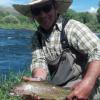-
Content Count
16 -
Joined
-
Last visited
-
Nice ties.
-
Been tying a lot of Minkies, a common UK lake streamer pattern, but what to do with all the little offcuts of fur. Step in the Mink Hog, a Rob Denson variant on a popular Scottish loch pattern. Hook: Fulling Mill 5105 #10 Tail: White mink Body: White and silver micro UV straggle Wing: Several bunches of mink tied in Hog-style Hackle: Silver bager rooster Cheeks: Split jungle cock Thread: Danville’s 70 denier black …and the Minkie. Hook: Fulling Mill 5085 #10 Rib: Silver wire Body: UV Straggle Fritz Wing: Brown Mink Zonker Head: Fish Skull mask and eyes Thread: Danville’s 70 denier black
-
Might be of interest that in his book American Fly Fishing - A History Paul Schullery has a wonderful chapter entitled Imitation's Forgotten Prophets one of whom was Louis Rhead, though Schullery notes that it is difficult to assess his contribution to the development of American fly fishing, in part because he was not particularly successful at some of his commercial attempts to market his flies. In some 6 pages on Rhead he notes the following: Schullery, Paul. (1987) American Fly Fishing - A History. Lyons Press.
-
Hi Scott, George's first book was self published, not sure how easy it is to get a copy these days. Could try emailing him: [email protected]. His second book "A fine Line" is still available. Iain
-
No problem, there's a full res version on flickr - https://flic.kr/p/2o3cvXT
-
 olive_dabbler changed their profile photo
olive_dabbler changed their profile photo
-
Hook: Ahrex FW580 #8 Rib: Gold wire Body: Black and gold micro straggle fritz Tail/Back: Matched pair of jungle cock shoulder feathers, tied in Matuka style Hackle: Furnace hen Cheeks: Jungle Cock Thread: Uni thread 8/0 black When you get to the end of George Barron’s excellent book ‘At the end of the line’ on classic loch style wet flies there are a couple of pages of flies that don’t really fall into the category of traditional wet flies. These are his ‘Newt Streamers’ based on the old Ace of Spades style with a Matuka style wing and refined over a number of years. Not posted in a while as, until this summer been without a decent macro lens after changing camera systems.
-
Hot Orange Muddlers Hook: Hayabusa 761 #10 Tail: Orange hen Rib: Gold wire Body: UTC Mirage Opal Body hackle: Grizzly hen dyed orange Shoulder hackle: Orange hen Head: Deer hair Thread: Danville 6/0 black
-
Corixa Hook: Hayabusa 761 #12 Rib: Silver wire Wing case and legs: Pheasant tail Body: Madeira metallic Col. 300 Thread: Danville 6/0 black This Corixa (lesser water boatman) pattern has its roots in a pattern attributed to Dr Bell of Blagdon, a pioneer of Stillwater fly fishing in the UK in the early 20th century. John Veniard, who wrote several seminal books on fly tying in the 1960s and 70s, cites an article in the Fishing Gazette of April 1958 where this and several other of Dr Bell’s flies are described by a Col. Esmond Drury. Dr Bell’s original pattern uses a body of white or cream floss and a wing case of woodcock wing fibres using a cream throat hackle to imitate the legs. The body on this pattern is tied with Madeira metallic thread, which gives it a rather nice transparency, simulating the air bubble that these insects use to breath underwater.
-
Has the characteristics of a generic imitative soft hackle pattern. We use one in the UK called 'The Cruncher' (no idea how it got its name but it started life as a PTN derivative with a soft hackle) but it has many, many, variants like the ginger hackled one below. Very effective style of fly.
-
No offence taken, 500 year old buildings are a right pain to have to look at and don't get me started on thatched cottages. I'm not sure if you're being serious or not. In my opinion, nothing built by man is worth looking at. Those 500 year old buildings, thatched roofs, the Pyramids, etc. ... all just blisters on the landscape. Maybe this will help!
-
No offence taken, 500 year old buildings are a right pain to have to look at and don't get me started on thatched cottages.
-
OH=Other Half=wife!
-
Corixa Cruncher Hook: Tiemco 3769 or 9300 #10-14 Tail: Brown rooster hackle fibres Back: Hen pheasant Rib: Silver wire Body: Madeira metallic Col. 300 (Pearl) Hackle: Brown rooster, kept to around 1/2 a shank's length Thread: Uni 8/0 white, switched for brown for head. Head tied large. I first discovered Madeira metallic threads by raiding the OH's embroidery cabinet! The pearl version has become a staple for corixa patterns - makes superb bodies and to adjust the thickness all it takes is more wraps. A more suggestive pattern than other corixa patterns I've tied, based on a similar pattern from Davie McPhail, but it is so quick to tie in a range of sizes. Thanks for looking.
-
Here's mine. In return for the view over the village green and its medieval church, I'm under strict orders to keep the study tidy! The Gerstners, which house much of my material, are a very special and deeply personal gift I received many years back.
-
Afraid you've lost me - I do hope gum nuts means something different than it does this side of the pond !


